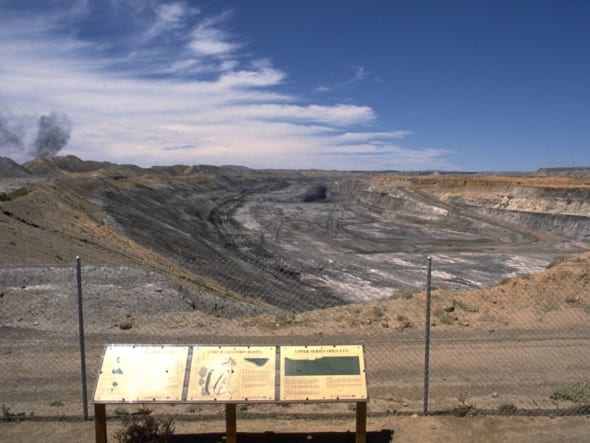South Australia, a small state, loves to be first. It was the first jurisdiction to grant women the vote and for establishing a system of land tenure, and it could be the first to reach “net 100 per cent renewables” through wind and solar.
But it’s also about to take a massive step backwards by giving the green light to a particularly dangerous extraction method for fossil fuel; underground coal gasification (UCG), with an encore from unproven carbon capture and storage (CCS) described by the proponent as “sequestration underground.”
The plan is to build in Leigh Creek’s abandoned coal field in the state’s north a “carbon-neutral” plant to manufacture urea, which would be sold as fertiliser.
The UCG process of setting fire to coal underground releases a mixture of carbon monoxide, carbon dioxide, methane, hydrogen and many toxic chemicals from coal seams or formed during combustion.
In 2019, the Doctors for the Environment Australia and the Conservation Council SA made a strong recommendation that this underground coal gasification project should not proceed, in a joint submission to an Environmental Impact Report from Leigh Creek Energy.
Today, the case against the project is even more compelling.
Nevertheless, the proposal is once more in the public domain, because the South Australian government has overruled opposition to development by the Traditional Owners of Leigh Creek, the Adnyamathanha people, and approved the project under the Aboriginal Heritage Act!
The Adnyamathanha people’s opposition was voiced in 2018 when their leader said it was time to “heal this area, not fill it with poison,” and “this is a very important Muda (spirituality) and the desecration of this site has to stop.”
Despite this appeal from the Traditional Owners, whose connection to the country around Leigh Creek is infused with important songlines about Yulu’s coal, the decision was delegated away from Premier Steven Marshall, who has responsibility for Aboriginal Affairs and Reconciliation, to a minister who is about to retire in two months.
That minister’s approval of the Leigh Creek project continues the reprehensible tradition of all governments in Australia of disregarding the views of Aboriginal peoples in virtually all coal and gas projects.
Meanwhile, the environmental and health arguments against the project continue to pile up. In 2016, a Scottish report on UCG and its hazards, written by Campbell Gemmell, former head of the EPA in South Australia and now Visiting Professor in Law at Strathclyde University, concluded there was insufficient evidence to regard UCG as a safe and viable process.
There has been no further comprehensive scientific review since 2016, which in itself should bring increased caution to any new proposal – particularly since millions of dollars have been spent at Leigh Creek without reaching commercial benchmarks.
In 2016, the Linc Energy UGC disaster in Queensland resulted in widespread contamination of land, water and harm to the health of workers, after the project failed to control the combustion of coal underground.
In 2018 Linc was found guilty of five counts of causing serious environmental harm by polluting farmland over a wide area near Chinchilla with hazardous contaminants, despite warnings from scientists.
At the time of the DEA/CCSA submission in 2019, bad press and negative impacts had resulted in closure of several such developments nationally and internationally. Today the situation remains unchanged, UCG remains a risky procedure on all assessable criteria.
The DEA/CCSA submission also opposed the proposal because there were national and international imperatives to urgently reduce greenhouse gas emissions. Today this is even more urgent. The Leigh Creek development attempts to address this issue by proposing a form of carbon capture and storage (CCS) for the carbon dioxide released by UCG.
Gas and oil extraction in the US has defined many possible health and environmental hazards which have not been investigated in Australia, particularly groundwater contamination and particularly in dry regions.
These concerns now extend to the release from rocks of contaminants such as lead and arsenic into water acidified by carbon dioxide in the carbon capture process. These are additional to the many toxins such as PAHs (polycyclic aromatic hydrocarbons) and EDCs (endocrine disrupting chemicals) released from coal seams.
Unfortunately, a Health Impact Assessment is not made in the current Environmental Impact Report for Leigh Creek Energy. It must be requested.
This raises concerns over potential contamination of the Telford Basin groundwater resources adjacent to the Great Artesian Basin. Investigation of potentially communicating water systems has not yet been reported on by the Independent Expert Scientific Committee on Coal Seam Gas and Large Coal Mining Development which provides independent, expert, scientific advice to the Australian and state government regulators.
It must be recognised that underground water resources are fundamental to the security of South Australia in an era of climate change and diminution of rainfall, see submission on Water Security Statement 2021.
While it is recognised that existing saline water may have to be desalinated for use in UCG, its additional use in CCS was not explained. Concern must be expressed for the likely impacts on the already fragile ecology of the surrounding area and vulnerable species of birds and plant life.
Australia’s natural environment is deteriorating rapidly and any further damage must be avoided. No doubt the proposed area will be regarded as of little economic value by the South Australian government because of its arid conditions and previous degradation from coal mining.
Unfortunately, there is little understanding that the ecology of this region is linked to the environmental health of surrounding regions and the cultural and physical health of Traditional Owners. We must reform our thinking and approach if we are to survive on this fragile continent.
Professor David Shearman is AM PhD FRACP is emeritus professor of Medicine, University of Adelaide and Co-Founder, Doctors for the Environment Australia. Craig Wilkins is Chief Executive of the Conservation Council of SA
They acknowledge the assistance of Associate Professor Gavin Mudd, School of Engineering at RMIT University










